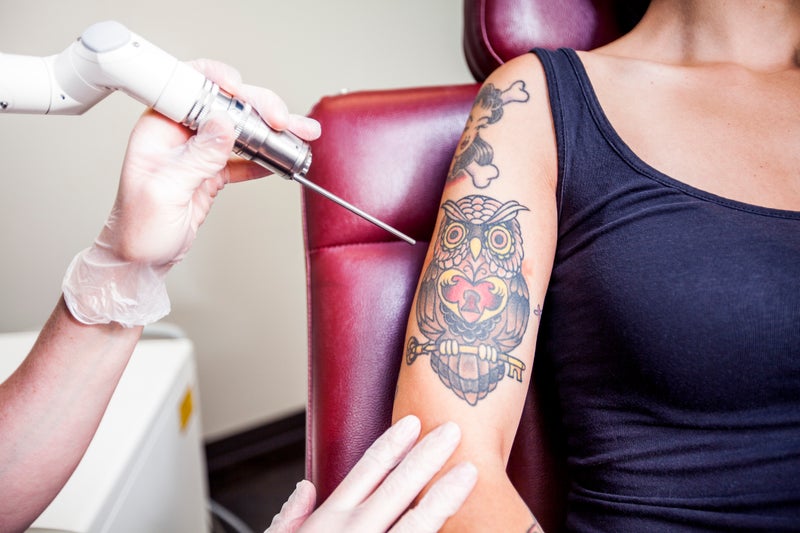What happens if you go off your body art? Katie Rosseinsky hears from the people who’ve embarked on the lengthy, pricey process of getting rid of their ink. A tattoo is for life, right? Or at least, that’s what concerned grown-ups would always claim while trying to discourage your 18-year-old self from getting inked on holiday. But the truth is much less black and white – or should that be blue-ish and white? – as comedian Pete Davidson has found out.
![[Edwards’ ambigram tattoo before and after multiple removal sessions]](https://static.independent.co.uk/2025/02/18/15/07/MixCollage-18-Feb-2025-03-57-PM-7713.jpg)
About four years ago, the former Saturday Night Live star started getting rid of around 200 tattoos. Earlier this month, he showed off the results by posing in his pants in an ad campaign for fashion brand Reformation, looking pretty much ink-free. For Davidson, it’s been a long and apparently painful slog. “It’s horrible,” he told Jimmy Fallon during an appearance on The Tonight Show. “It’s worse [than getting a tattoo]. They’ve got to burn off a layer of your skin.”.
![[Comedian Pete Davidson showed the results of his extensive tattoo removal in a new Reformation ad campaign]](https://static.independent.co.uk/2025/02/12/10/06/Pete-Davidson-Official-Boyfriend-of-Reformation_2.jpg)
Davidson has reportedly blown around $200,000 (£159,000) so far on his quest to turn his body back into a blank canvas. The typical customer probably won’t need to spend anywhere near that amount, but the cost of tattoo removal certainly adds up. “On average, small tattoos start from £50 per session, and larger tattoos may be £100 plus per session,” says Dr Patel. Take into account the fact that most designs will require six sessions minimum and you’re looking at a hefty investment.
More than a decade later, Edwards got to the point where she wanted to remove it. Another cover-up wasn’t an option, “because it just meant going even larger” – and a full sleeve didn’t exactly appeal. For the past year and a half, she has visited a tattoo removal studio in St Albans every six weeks or so; she’s now gearing up for her 12th session. Another “four or five” should get rid of it completely: it’s taken so long “because it was a very heavy pattern, with the ink tightly packed in, and because of the fact it was a cover-up”. Her sons, now teenagers, inevitably “keep teasing me about it. They’re like, ‘That’s it, you’re erasing us!’”.
I’ve had some people who’ve been on the stag do, who were drunk and didn’t even know they got the tattoo, they were so mortified that their wife-to-be was gonna find out. No tattoo is the same, and there are plenty of factors that will impact exactly how long the removal process takes. Tattoos on the extremities of the body tend to take longer to eliminate. Essentially, “if your ink is further away from your heart”, Hyland says, it will take longer, because the blood flow is lower. “If I had exactly the same tattoo on my ankle and my shoulder, and we did the exact same treatment at the same time, the one on my shoulder would go quicker because your heart has to work less hard and your immune system has to work less hard to remove the particles there.” And “if someone smokes [or] drinks a lot, then they are compromising the immune system, so therefore the tattoo removal journey will take longer”. In 2012, researchers in Milan discovered that smoking can reduce the chance of successfully getting rid of a tattoo after 10 treatments by as much as 70 per cent.
Different ink shades also respond to lasers in different ways, because each absorbs different wavelengths of light. A picosecond laser should be able to get rid of most colours, but if you’re being treated with a more traditional Q-switched laser, “a Ruby [laser] is the best one to remove green ink, whereas Nd:Yag [laser] is best for black and blue inks”, says Hyland. “To get rid of reds, browns, oranges, you need a KTP laser, which is a green light.” Sometimes, she adds, it can be tricky to find a studio that has the technology required to get rid of every colour.
Your skin tone affects the process, too. Darker skin has more melanin, which can absorb more of the laser’s light energy, and requires “careful laser selection and lower energy settings”, cautions Dr Patel, to avoid hypopigmentation or hyperpigmentation (skin discolouration caused by too little or too much pigment).
After the treatment, “the skin may feel warm, swollen or slightly tender, similar to mild sunburn”, says Dr Patel. You might experience redness or pinpoint bleeding, “but this typically settles within a few hours to a few days”, he adds. Blistering might occur, too. In between sessions, you’ll need to steer clear of sun exposure, apply high-factor sunscreen and avoid picking at the area. If the skin is clear, without scabs or blisters, massaging the skin can help stimulate the blood flow.
Hyland says she often gets bookings from brides-to-be, trying to get rid of their body art before walking down the aisle. “[With] anything that’s visible around their neckline, on their wrist, you get a lot of brides suddenly thinking, ‘Oh my God, this tattoo’s gonna be on show, what am I gonna do?’” she says. Often, though, they underestimate just how long it takes. “They’ll come in March and go, ‘I’m getting married in August, can you get rid of this?’” That’s not the only type of pre-nuptial customer she’s seen. “I’ve had some people who’ve been on the stag do, who were drunk and didn’t even know they got the tattoo,” she says. “They were so mortified that their wife-to-be was gonna find out, so they had to get rid of it.”.































